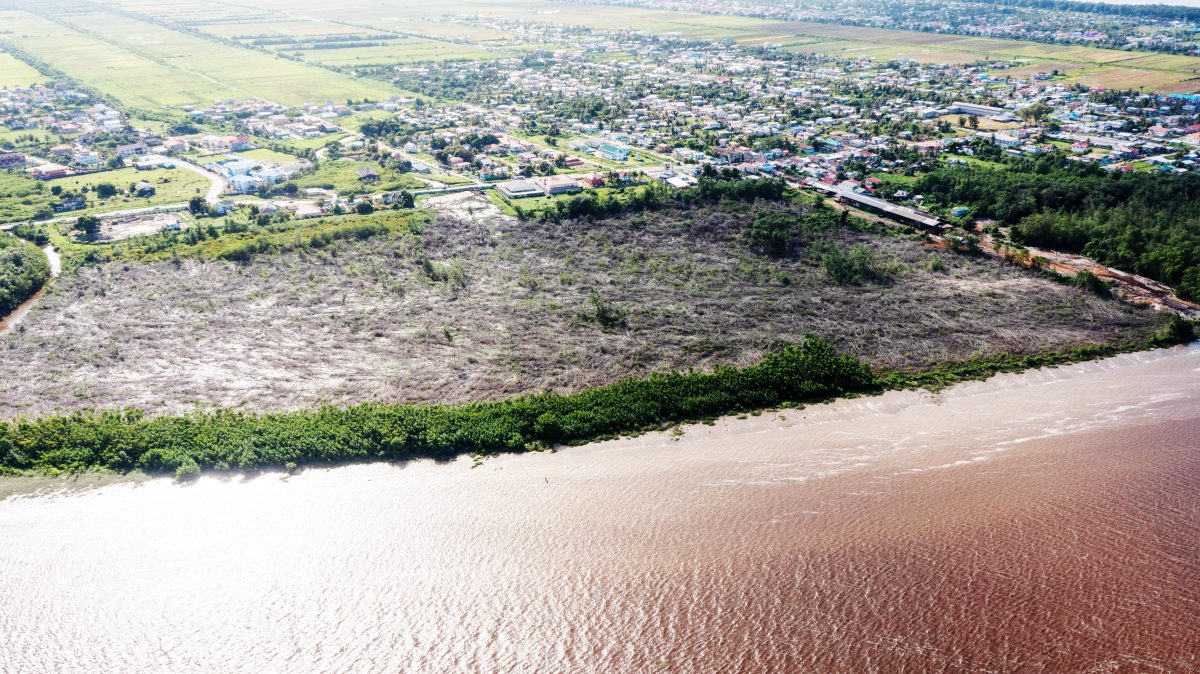nvironmentalist Annette Arjoon-Martins yesterday called for sanctions against the company which destroyed a large swathe of mangroves on the West Demerara while in the process of establishing a shore base for the oil and gas industry.
Tristar Incorporated – whose principals are so far unknown – exceeded the amount of mangroves which were permitted to be cut in the Malgre Tout/Versailles area.
Arjoon-Martins, a former chair of the Mangrove Restoration Programme told Stabroek News that as part of the sanctions the developers should be tasked with replanting the coastal shrub, equivalent to two times the amount destroyed in their land clearing activity.
She noted that even though they will not be able to replant the trees at the location from where they were cleared, they can fund the National Agricultural Research and Education Institute’s (NAREI) restoration programme on the East Coast of Demerara.
Chairman of Guyana’s Sea Defence Board Gary Beaton on Thursday told Stabroek News that the developer cleared a large amount of mangroves, which it was not permitted to do, and has so far failed to make provisions to rebuild a river defence.
“They are in breach of the guidelines we offered with our no-objection. They have destroyed the sea defence without building one area, and they were expected to provide a work plan and schedule but that was not done,” Beaton said when asked about the breaches committed by the developer.
It is unclear why the sea defence board had not been able to stop the large-scale destruction.
Arjoon-Martins yesterday said that it is worrying that at a time of climate change crisis where mangroves are threatened “we have a situation where they are being cut down and cleared for a development”. She stressed that every effort must be made to protect the plants which form a natural sea defence for many parts of Guyana.
She added that a strong message must be sent to stop others from engaging in this practice.
“Even if a concretized structure is built to protect the residents from the rising sea levels, we have to understand that it does not have the same value and benefits mangroves have. Mangroves are regarded as a carbon sink and absorb five times the amount of carbon (absorbed by) Green Heart and Purple Heart forests. In addition to that, it fosters a rich eco system and serves as a nursery for fishes and a habitat for birds,” Arjoon-Martins said.
Mangroves are a protected species here and concerns have been expressed previously that the oil and gas industry will pose a threat to large swathes.
Arjoon-Martins said that given the environmental implications, Guyana’s lone oil producer ExxonMobil should make their position clear on what is expected of subcontractors and service providers.
ExxonMobil has been working to improve their image on the environmental front and Arjoon-Martins said their shareholders have been pushing for the company to be more environmentally friendly in their daily operations.
Should the company take a position on this, she said it can be a positive as companies will be forced to act and adhere to the environmental laws of the country.
“If the pressure from its shareholders who care about the environment matters it can atone by making it clear to potential contractors that such environmentally destructive development will have consequences,” she asserted.
Beaton on Thursday told this newspaper that the Board would be summoning the developer to a meeting and hopefully they will be able to meet during this week.
A visit on Tuesday by Stabroek News to the area revealed that a substantial amount of mangroves had been cleared along the shoreline earmarked for the project and residents have expressed worry that they are now vulnerable to flooding, especially since the May/June rainy season has started.
Aerial images commissioned by this newspaper have revealed a devastating situation as a vast swathe of the mangrove forest has been cleared and the developers are in the process of clearing the final stretch of the protected plants on the foreshore.
To date, key agencies such as the Environmental Protection Agency and NAREI have remained silent on the situation. The Guyana Forestry Commission which also forms a part of the enforcement chain has also been silent on the issue.
When residents recognised that the destruction of the mangroves had possibly exceeded the amount that was approved, they began to question what sort of river defence would be put in place to protect them.
“We are concerned as mangroves provide coastal defence against flooding… and their removal is a major concern to us…flooding remains a major concern to us,” resident Shawn Johnson said in a letter to Stabroek News on behalf of other residents.
Additionally, when Stabroek News spoke with the Chairman of the Malgre Tout/Meten-Meer-Zorg Neighbourhood Democratic Council, Tennessee Vickerie, he explained that during consultations the council had raised objections to the destruction of the mangroves. He noted that it communicated its concern among others to the Central Housing and Planning Authority and other agencies during the process for approval of the project.





